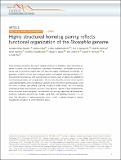| dc.contributor.author | AlHaj Abed, Jumana | |
| dc.contributor.author | Erceg, Jelena | |
| dc.contributor.author | Goloborodko, Anton | |
| dc.contributor.author | Nguyen, Son C. | |
| dc.contributor.author | McCole, Ruth B. | |
| dc.contributor.author | Saylor, Wren | |
| dc.contributor.author | Fudenberg, Geoffrey | |
| dc.contributor.author | Lajoie, Bryan R. | |
| dc.contributor.author | Dekker, Job | |
| dc.contributor.author | Mirny, Leonid A. | |
| dc.contributor.author | Wu, C.-ting | |
| dc.contributor.author | Goloborodko | |
| dc.date.accessioned | 2020-05-06T15:37:48Z | |
| dc.date.available | 2020-05-06T15:37:48Z | |
| dc.date.issued | 2019-10 | |
| dc.date.submitted | 2018-12 | |
| dc.identifier.issn | 2041-1723 | |
| dc.identifier.uri | https://hdl.handle.net/1721.1/125053 | |
| dc.description.abstract | Trans-homolog interactions have been studied extensively in Drosophila, where homologs are paired in somatic cells and transvection is prevalent. Nevertheless, the detailed structure of pairing and its functional impact have not been thoroughly investigated. Accordingly, we generated a diploid cell line from divergent parents and applied haplotype-resolved Hi-C, showing that homologs pair with varying precision genome-wide, in addition to establishing trans-homolog domains and compartments. We also elucidate the structure of pairing with unprecedented detail, observing significant variation across the genome and revealing at least two forms of pairing: tight pairing, spanning contiguous small domains, and loose pairing, consisting of single larger domains. Strikingly, active genomic regions (A-type compartments, active chromatin, expressed genes) correlated with tight pairing, suggesting that pairing has a functional implication genome-wide. Finally, using RNAi and haplotype-resolved Hi-C, we show that disruption of pairing-promoting factors results in global changes in pairing, including the disruption of some interaction peaks. Keywords: Computational biology and bioinformatics; Epigenetics; Functional genomics; Molecular biology | en_US |
| dc.description.sponsorship | National Institute of General Medical Sciences (U.S.) (Grant R01HD091797) | en_US |
| dc.description.sponsorship | National Institute of General Medical Sciences (U.S.) (Grant R01GM123289) | en_US |
| dc.description.sponsorship | National Institute of General Medical Sciences (U.S.) (Grant DP1GM106412) | en_US |
| dc.description.sponsorship | National Institute of General Medical Sciences (U.S.) (Grant R01 GM114190) | en_US |
| dc.language.iso | en | |
| dc.publisher | Springer Science and Business Media LLC | en_US |
| dc.relation.isversionof | http://dx.doi.org/10.1038/s41467-019-12208-3 | en_US |
| dc.rights | Creative Commons Attribution 4.0 International license | en_US |
| dc.rights.uri | https://creativecommons.org/licenses/by/4.0/ | en_US |
| dc.source | Nature | en_US |
| dc.title | Highly structured homolog pairing reflects functional organization of the Drosophila genome | en_US |
| dc.type | Article | en_US |
| dc.identifier.citation | AlHaj Abed, Jumana et al. "Highly structured homolog pairing reflects functional organization of the Drosophila genome." Nature Communications 10 (October 2019): 4485 ©2019 The Author(s) | en_US |
| dc.contributor.department | Massachusetts Institute of Technology. Institute for Medical Engineering & Science | en_US |
| dc.contributor.department | Massachusetts Institute of Technology. Department of Physics | en_US |
| dc.relation.journal | Nature Communications | en_US |
| dc.eprint.version | Final published version | en_US |
| dc.type.uri | http://purl.org/eprint/type/JournalArticle | en_US |
| eprint.status | http://purl.org/eprint/status/PeerReviewed | en_US |
| dc.date.updated | 2019-10-09T17:03:43Z | |
| dspace.date.submission | 2019-10-09T17:03:50Z | |
| mit.journal.volume | 10 | en_US |
| mit.journal.issue | 1 | en_US |
| mit.metadata.status | Complete | |

